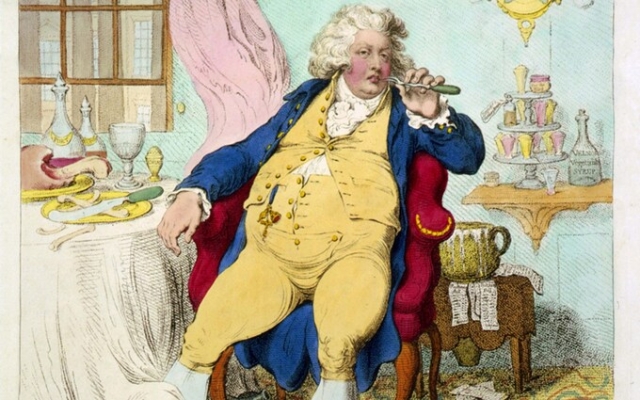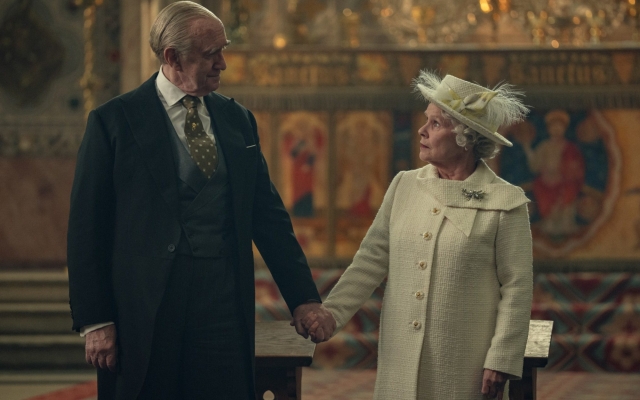 James Gillray «The Voluptuary Under the Horrors of Digestion», 1792
James Gillray «The Voluptuary Under the Horrors of Digestion», 1792
It's a sobering thought: due to the popularity of the Netflix soap opera » The Crown, now airing its final episodes, and the insatiable desire to see the royal family as celebrities first and constitutional figures second, the series has become the premier representation of the House of Windsor in popular culture.
Unfortunately, this presentation does nothing to reduce the stunningly historically false content of much of the series: in fact, it only makes the situation worse, as more people, insufficiently educated in history and current events, absorb all the tripe. contained in many of his scripts, and believe that they will learn something true.
One of the most distinguished courtiers of the last century, Sir Frederick «Fritz» Ponsonby, after nearly 50 years of service to Queen Victoria, Edward VII and George V, said he had come to understand that history is not what happened in fact, but what actually happened. people thought this happened: Hello Netflix!
Yet for all the fabrications, fantasies and outright insults to the living and (mostly) dead that The Crown contains, history suggests that the current version of our royal family has had it pretty easy. For centuries, the attempts of rebels, satirists and republicans to speak on behalf of the people against the monarch were far more unpleasant than anything the Crown could offer, and the retribution demanded for it was far more disgusting than any lawyer's letter.
Part of the reason for this was that in past eras the Monarch had much more power than he does now. He, and sometimes she, was the source of executive power, and for several hundred years the battle was waged to stop it. King Charles III is a full constitutional monarch, meaning he only has “reserve” powers and not executive powers. For better or worse, he does exactly what his prime minister tells him. Therefore, unless the monarch does something personally reprehensible (and given that the king has serious advisers, as well as decades of his own preparation for his job, this remains extremely unlikely), it is doubtful that he will deserve the attack of the people.

It is difficult to know which of the myths propagated by The Crown is the most poisonous: that the King, as Prince of Wales, conspired with John Major to force the late Queen to abdicate; that his late wife was a completely passive victim and played no role in the breakdown of their marriage; that the late Queen kissed Churchill goodbye on her deathbed; that Earl Mountbatten supported the idea of a coup against Harold Wilson; that the late Queen had a romantic interest in Lord Porchester, her racing manager; that the Princess Royal had an affair with Andrew Parker Bowles; and that the relationship between Mrs Thatcher and the late Queen was toxic.
The late Queen was on the verge of sainthood when she died, and even the left-wing press was extremely reluctant to caricature her, let alone attack her. If The Crown is going to be her home in popular culture, then one can only say that she deserves much better. Both she and her heir, when it came to public Aunt Sally, benefited greatly from one of the salutary facts about our political system: in our day, the political class now makes all major political decisions in the name of the Sovereign. and are treated with such hatred by the public that the late Queen, and now the King after her, are seen by many as a welcome relief from some of those who now rule us.
When kings had enormous power, they were an obvious target for attack, but the penalties for doing so were so draconian that only the brave or reckless would do so. Indeed, the safest thing to do was wait until the monarch was dead before allowing popular culture to do evil things to him, albeit as a commentary on the present.
King Charles and Queen Camilla performed by Dominic West and Olivia Williams. Photo: Justin Downing/Netflix
It is no coincidence that the most popular version of the Robin Hood legend gained fame in the 15th century, when the royal houses of York and Lancaster destroyed themselves and their followers on the battlefields. Instead of attacking a living tyrant, as many believed Richard III to be, the ballad writers praised Robin Hood and used him as a counterweight to the bad King John. A hundred years later, most writers wanted to ingratiate themselves with Queen Elizabeth, so Spenser delighted in The Faerie Queene, while Shakespeare exalted her and her Tudor ancestors, not least pillorying Richard III as a deformed murderer and Henry VI as a blockhead (in three parts).
Henry VIII was not famous for his indulgent self-deprecation, but the discovery in 2020 of a letter by Matthew Dimmock, a professor at the University of Sussex, showed that popular opinion of him towards the end of his reign was predictably caustic. The letter is believed to date from around the time of the collapse of Henry's marriage to Anne of Cleves. It supposedly came from the Antichrist — or Balthasar, Emperor of Babylon and ruler of Hell — and asked if the king would like to marry his daughter and collect a dowry of eight million gold sovereigns and the cross on which Christ was crucified.
If the writer had been discovered, he would have been executed, probably using Henry's favorite method: immersion in boiling oil. However, the Reformation led to greater freedom of thought, and the change of dynasty in 1603 gave the radicals plenty of ammunition. In 1632, the Puritan polemicist William Prynne published a book condemning stage plays, which was interpreted as an attack on the stage-stricken Queen Henrietta Maria, as well as an attack on King Charles I. He failed to suppress these plays and was compared to Nero.
The book was burned, Prynne was thrown into the Tower for a year pending trial, sentenced to life imprisonment, fined £5,000, and ordered to have his ears cut off in the pillory. Parliament later declared his punishments illegal; The civil war, provoked by the autocratic behavior of the king, led to the beheading of Charles. When his son became the subject of widespread gossip after the Restoration about his sexual intemperance and parade of illegitimate sons, he did not take the bait, perhaps recalling his father's fate.
 George III and Queen Charlotte stand in front of the Treasury with bags of money under their arms. Photo by James Gillray, 1786. Photo: editorial by Universal Images Group
George III and Queen Charlotte stand in front of the Treasury with bags of money under their arms. Photo by James Gillray, 1786. Photo: editorial by Universal Images Group
By Georgian times our constitutional monarchy was almost fully formed, and therefore gross personal misconduct was required to attack the royal power. The Prince Regent, later George IV, was a prime target due to his terrible treatment of his wife, his gluttony and his enormous spending. His first pursuer was the artist James Gillray, whose 1792 cartoon «The Voluptuous Man in the Horrors of Digestion» depicts a huge stomach lying on a chair with its head and limbs attached. It is, in fact, the prince picking his teeth with a fork, surrounded by the remains of a huge meal and in the company of an overflowing chamber pot — a final detail brilliantly designed to show what a disgusting person Gillray considered George.< /p>
This was not the only such photograph of the Prince that Gillray took, and it and other depraved images of the Prince contributed to his growing unpopularity. Despite an investigation into whether the deeply humiliating photographs might constitute libel, sedition or treason, Gillray went unprosecuted: indeed, for several years he was on the government's payroll attacking its enemies. Leigh Hunt, later one of the most important writers of the Victorian era, was not so lucky. When in 1812 he wrote and his brother published a furious attack on the regent — prompted by a flattering article about him in the Morning Post — the prince brought down the full force of the law on them.
Hunt pointed out the regent's widespread unpopularity; his lack of patronage of the fine arts; his pathetic inability to speak in public; its completeness; his depraved behavior; his extravagance; his low friends; his gambling and the fact that he is «a man who has just lived half a century without claiming either the gratitude of his country or the respect of posterity.» The Hunts were charged with libel, fined £500 each, sent to prison for two years and made to pay a bond for their future good behavior. The social and literary community rallied around them, sending lavish dinners to their prison cells; The Regent managed to provoke even greater hatred than before.
 The Crown has fueled many myths about the royal family. Photo: Netflix
The Crown has fueled many myths about the royal family. Photo: Netflix
And it's often forgotten how cruelly pop culture treated Queen Victoria. Her near-invisibility for a decade after Prince Albert's death helped fuel a strong republican movement in Britain, with much pamphleting and demands to emulate France, which had just declared its Third Republic. One such pamphlet was entitled «What's She Doing with It?», where «it» referred to the huge sums she received from the Civil List without apparently doing anything in return. It was not until the Golden Jubilee of 1887 that the storm subsided and she became the «dear old queen».
And after that the royal family became increasingly docile and popular, coupled with a more deferential press. , seemed to wrest the monarchy from popular culture. Edward VII's extramarital adventures were ignored. The leadership of George V and George VI in the two world wars cemented the public's affection for them.
Edward VIII's abdication was seen almost as a personal grief until it was over. The Crown has moments of injustice, malice, and even outright cruelty in the way it dehumanizes people whose only crime was that they suffered an accident at birth; and it cruelly misleads all who think it is history. But when the House of Windsor reflects on the more distant past, it must breathe a sigh of relief and think that things could have been worse.


























































Свежие комментарии